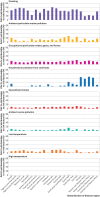Burden of chronic obstructive pulmonary disease and its attributable risk factors in 204 countries and territories, 1990-2019: results from the Global Burden of Disease Study 2019
- PMID: 35896191
- PMCID: PMC9326843
- DOI: 10.1136/bmj-2021-069679
Burden of chronic obstructive pulmonary disease and its attributable risk factors in 204 countries and territories, 1990-2019: results from the Global Burden of Disease Study 2019
Abstract
Objective: To report the global, regional, and national burden of chronic obstructive pulmonary disease (COPD) and its attributable risk factors between 1990 and 2019, by age, sex, and sociodemographic index.
Design: Systematic analysis.
Data source: Global Burden of Disease Study 2019.
Main outcome measures: Data on the prevalence, deaths, and disability adjusted life years (DALYs) of COPD, and its attributable risk factors, were retrieved from the Global Burden of Disease 2019 project for 204 countries and territories, between 1990 and 2019. The counts and rates per 100 000 population, along with 95% uncertainty intervals, were presented for each estimate.
Results: In 2019, 212.3 million prevalent cases of COPD were reported globally, with COPD accounting for 3.3 million deaths and 74.4 million DALYs. The global age standardised point prevalence, death, and DALY rates for COPD were 2638.2 (95% uncertainty intervals 2492.2 to 2796.1), 42.5 (37.6 to 46.3), and 926.1 (848.8 to 997.7) per 100 000 population, which were 8.7%, 41.7%, and 39.8% lower than in 1990, respectively. In 2019, Denmark (4299.5), Myanmar (3963.7), and Belgium (3927.7) had the highest age standardised point prevalence of COPD. Egypt (62.0%), Georgia (54.9%), and Nicaragua (51.6%) showed the largest increases in age standardised point prevalence across the study period. In 2019, Nepal (182.5) and Japan (7.4) had the highest and lowest age standardised death rates per 100 000, respectively, and Nepal (3318.4) and Barbados (177.7) had the highest and lowest age standardised DALY rates per 100 000, respectively. In men, the global DALY rate of COPD increased up to age 85-89 years and then decreased with advancing age, whereas for women the rate increased up to the oldest age group (≥95 years). Regionally, an overall reversed V shaped association was found between sociodemographic index and the age standardised DALY rate of COPD. Factors contributing most to the DALYs rates for COPD were smoking (46.0%), pollution from ambient particulate matter (20.7%), and occupational exposure to particulate matter, gases, and fumes (15.6%).
Conclusions: Despite the decreasing burden of COPD, this disease remains a major public health problem, especially in countries with a low sociodemographic index. Preventive programmes should focus on smoking cessation, improving air quality, and reducing occupational exposures to further reduce the burden of COPD.
© Author(s) (or their employer(s)) 2019. Re-use permitted under CC BY-NC. No commercial re-use. See rights and permissions. Published by BMJ.
Conflict of interest statement
Competing interests: All authors have completed the ICMJE uniform disclosure form at www.icmje.org/disclosure-of-interest/ and declare: support from Shahid Beheshti University of Medical Sciences for the submitted work; no financial relationships with any organisations that might have an interest in the submitted work in the previous three years; no other relationships or activities that could appear to have influenced the submitted work.
Figures





References
-
- Vos T, Lim SS, Abbafati C, et al. GBD 2019 Diseases and Injuries Collaborators . Global burden of 369 diseases and injuries in 204 countries and territories, 1990-2019: a systematic analysis for the Global Burden of Disease Study 2019. Lancet 2020;396:1204-22. 10.1016/S0140-6736(20)30925-9. - DOI - PMC - PubMed
-
- James SL, Abate D, Abate KH, et al. GBD 2017 Disease and Injury Incidence and Prevalence Collaborators . Global, regional, and national incidence, prevalence, and years lived with disability for 354 diseases and injuries for 195 countries and territories, 1990-2017: a systematic analysis for the Global Burden of Disease Study 2017. Lancet 2018;392:1789-858. 10.1016/S0140-6736(18)32279-7. - DOI - PMC - PubMed
-
- Soriano JB, Kendrick PJ, Paulson KR, et al. GBD Chronic Respiratory Disease Collaborators . Prevalence and attributable health burden of chronic respiratory diseases, 1990-2017: a systematic analysis for the Global Burden of Disease Study 2017. Lancet Respir Med 2020;8:585-96. 10.1016/S2213-2600(20)30105-3. - DOI - PMC - PubMed
MeSH terms
LinkOut - more resources
Full Text Sources
Other Literature Sources
